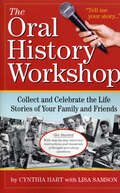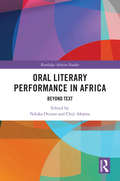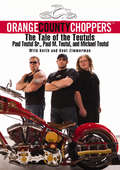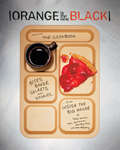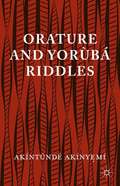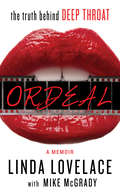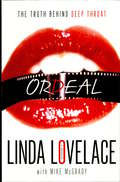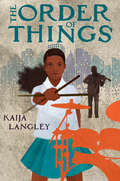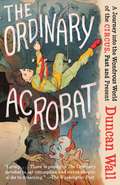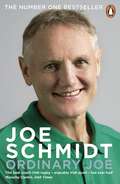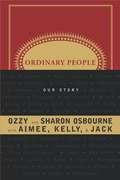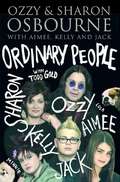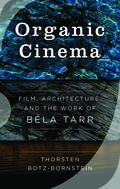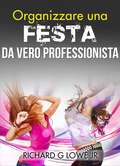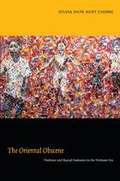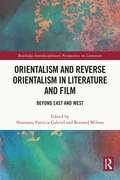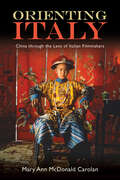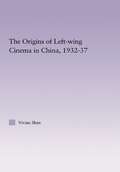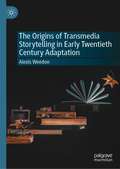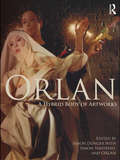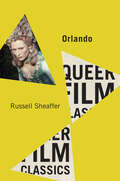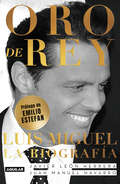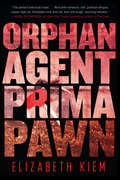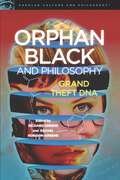- Table View
- List View
The Oral History Workshop: Collect and Celebrate the Life Stories of Your Family and Friends
by Lisa Samson Cynthia HartWe all know that we should ask now, before it's too late, before the stories are gone forever. But knowing and doing are two different things.Cynthia Hart, author of Cynthia Hart's Scrapbook Workshop, shows exactly how to collect, record, share, and preserve a family member's or a friend's oral history in this practical and inspirational guide. The Oral History Workshop breaks down what too often feels like an overwhelming project into a series of easily manageable steps: how to prepare for an interview; how to become a better listener; why there's always more beneath the surface and the questions to ask to get there; the pros and cons of video recording, including how your subjects should dress so the focus is on their words; four steps to keeping the interview on track; how to be attentive to your subject's energy levels; and the art of archiving or scrapbooking the interview into a finished keepsake.At the heart of the book are hundreds of questions designed to cover every aspect of your subject's history: Do you remember when and how you learned to read? Who in your life showed you the most kindness? What insights have you gained about your parents over the years? Would you describe yourself as an optimist or a pessimist? In what ways were you introduced to music? What is the first gift you remember giving? If you could hold on to one memory forever, what would it be? When the answers are pieced together, a mosaic appears—a living history.
Oral Literary Performance in Africa: Beyond Text (Routledge African Studies)
by Nduka Otiono and Chiji AkọmaThis book delivers an admirably comprehensive and rigorous analysis of African oral literatures and performance. Gathering insights from distinguished scholars in the field, the book provides a range of contemporary interdisciplinary perspectives in the study of oral literature and its transformations in everyday life, fiction, poetry, popular culture, and postcolonial politics. Topics discussed include folklore and folklife; oral performance and masculinities; intermediated orality, modern transformations, and globalization; orality and mass media; spoken word and imaginative writing. The book also addresses research methodologies and the thematic and theoretical trajectories of scholars of African oral literatures, looking back to the trailblazing legacies of Ruth Finnegan, Harold Scheub, and Isidore Okpewho. Ambitious in scope and incisive in its analysis, this book will be of interest to students and scholars of African literatures and oral performance as well as to general readers interested in the dynamics of cultural production.
Orange County ChoppersTM: The Tale of the Teutuls
by Paul M. Teutul Michael Teutul Paul Teutul Sr.Each week, millions of viewers tune into The Discovery Channel to watch their favorite dysfunctional American family, the Teutuls. The hit TV show American Chopper features Paul Teutul, Sr., and his sons Paul, Jr. and Mikey, along with a supporting cast of mechanics and friends. Together, they create some of the most incredible and outrageous motorcycles in the world. Now, in Orange County Choppers, the Teutuls combine family history with a behind-the-scenes tour of their renowned motorcycle shop-and their new lives as household names. Hilarious and heartwarming, fans of the show and newcomers alike will delight in this truly authentic America success story.
Orange is the new Black Presents: The Cookbook
by Jenji Kohan Tara Hermann Hartley Voss Alex Regnery“A fun read for fans of the Netflix series . . . And don’t worry: These dishes are way better than the food the inmates actually eat on the show” (People). Staffed and run by a band of misfit inmates, the kitchen at Litchfield is in many ways the center of the popular show Orange Is the New Black—a setting for camaraderie, drug smuggling, power struggles, and plot twists. And then there is the food. With sixty-five recipes, twelve sidebars that expand upon the fiction of the show, and sixty photographs from the show featuring favorite characters and memorable moments, Orange Is the New Black Presents: The Cookbook adds new dimensions to any fan’s obsession. The recipes cover three square meals a day, plus snacks/sides, desserts, and drinks. They include Red’s Chicken Kiev, Miss Claudette’s Coconut Cake, and Prison Punch. The sidebars include Taystee’s suggested prison reading list, the recipe for Red’s Homemade Homeopathic Remedies, and a prison glossary. Chock full of in-depth information about the show, including recipe headnotes by the characters, DIY projects that emulate notable props, and prison factoids that help bring the show to life, this cookbook will bring a little piece of Litchfield right into your very own kitchen.
Orature and Yorùbá Riddles
by Akíntúndé AkínyẹmíOrature and Yorùbá Riddles takes readers into the hitherto unexplored undercurrents of riddles in Africa. Because of its oral and all too often ephemeral nature, riddles have escaped close scrutiny from scholars. The strength of the Yorùbá as the focus of this study is impressive indeed: a major ethnic group in Africa, with established connections with the black diaspora in North America and the Caribean; a rich oral and written culture; a large and diverse population; and an integrated rural-urban society. The book is divided into six chapters for readers' convenience. When read in sequence, the book provides a comprehensive, holistic sense of Yorùbá creativity where riddles are concerned. At the same time, the book is conceived in a way that each chapter could be read individually. Therefore, those readers seeking understanding of a specific type of riddle may target a single chapter appearing most relevant to her/his curiosity.
Ordeal
by Linda Lovelace Mike McGradyGood Girl. Obedient Wife. Porn Slave. Deep Throat Was Only The Beginning Linda Boreman was just twenty-one when she met Chuck Traynor, the man who would change her life. Less than two years later, the girl who wouldn t let her high school dates get past first base was catapulted to fame she could never have imagined in her wildest dreams--or worst nightmares. Linda Boreman of Yonkers, New York, had become Linda Lovelace, international adult film superstar. The unprecedented success of Deep Throat made porn popular with the mainstream and made Lovelace a household name. But nobody, from the A-list celebrities who touted the movie to the audiences that lined up to see it, knew the truth about what went on behind the scenes. Enslaved by the man who would eventually force her into marriage so that he could control her completely, Linda was beaten savagely with regularity, hypnotized, and raped. She was threatened with disfigurement and death. She was terrorized into prostitution at gun and knifepoint. She was forced to perform unspeakable perversions on film. She made "Deep Throat" under unimaginable duress. Years later, Linda would come out of hiding to relate her side of the story--a modern horror tale of humiliation, betrayal, and violence that would rock the porn industry and put its teller in fear for her life. . . Ordeal Linda Lovelace became a household name in 1972, when "Deep Throat" became the first pornographic movie ever to cross over into the mainstream. Due to the success of "Deep Throat, " she appeared in "Playboy, Bachelor, " and even "Esquire" between 1973 and 1974. Soon after, Lovelace joined in with anti-pornography feminists led by Andrea Dworkin and Catharine MacKinnon, and she testified before Attorney General Meese s Commission on Pornography in 1986. She died in Denver on April 22, 2002, due to severe injuries in a car accident. Journalist and former syndicated columnist Mike McGrady"(Newsday, Los Angeles Times)" has written many books, and he was the chief catalyst for the bestselling novel "Naked Came the Stranger. ""
Ordeal
by Lovelace Linda Mcgrady MikeGood Girl. Obedient Wife. Porn Slave. Deep Throat Was Only The Beginning. . . Linda Boreman was just twenty-one when she met Chuck Traynor, the man who would change her life. Less than two years later, the girl who wouldn't let her high school dates get past first base was catapulted to fame she could never have imagined in her wildest dreams--or worst nightmares. Linda Boreman of Yonkers, New York, had become Linda Lovelace, international adult film superstar. The unprecedented success of Deep Throat made porn popular with the mainstream and made Lovelace a household name. But nobody, from the A-list celebrities who touted the movie to the audiences that lined up to see it, knew the truth about what went on behind the scenes. Enslaved by the man who would eventually force her into marriage so that he could control her completely, Linda was beaten savagely with regularity, hypnotized, and raped. She was threatened with disfigurement and death. She was terrorized into prostitution at gun and knifepoint. She was forced to perform unspeakable perversions on film. She made Deep Throat under unimaginable duress. Years later, Linda would come out of hiding to relate her side of the story--a modern horror tale of humiliation, betrayal, and violence that would rock the porn industry and put its teller in fear for her life. . . OrdealLinda Lovelace became a household name in 1972, when Deep Throat became the first pornographic movie ever to cross over into the mainstream. Due to the success of Deep Throat, she appeared in Playboy, Bachelor, and even Esquire between 1973 and 1974. Soon after, Lovelace joined in with anti-pornography feminists led by Andrea Dworkin and Catharine MacKinnon, and she testified before Attorney General Meese's Commission on Pornography in 1986. She died in Denver on April 22, 2002, due to severe injuries in a car accident. Journalist and former syndicated columnist Mike McGrady (Newsday, Los Angeles Times) has written many books, and he was the chief catalyst for the bestselling novel Naked Came the Stranger.
The Order of Things
by Kaija LangleyA heart-rending novel-in-verse about a girl beginning to learn it is possible to go on even after a great loss.Eleven-year-old April Jackson loves playing the drums, almost as much as she loves her best friend, Zee, a violin prodigy. They both dream of becoming professional musicians one day. When Zee starts attending a new school that will nurture his talent, April decides it&’s time for her to pursue her dreams, too, and finally take drum lessons. She knows she isn&’t very good to start, but with Zee&’s support, she also knows someday she can be just as good as her hero, Sheila E., and travel all around the world with a pair of drumsticks in her hand.When the unthinkable happens and Zee suddenly passes away, April is crushed by grief. Without Zee, nothing is the way it&’s supposed to be. Zee's Dad isn't delivering the mail for his postal route like he should. April's Mom is suddenly dating someone new who is occupying too much space in their lives. And every time April tries to play the drums, all she can think about is Zee.April isn't sure how to move on from the awful feeling of being without Zee. Desperate to help Papa Zee, she decides to secretly deliver the mail he&’s been neglecting. But when on her route she discovers a classmate in trouble, she doesn&’t second guess what she knows is the right thing to do.
The Ordinary Acrobat: A Journey into the Wondrous World of the Circus, Past and Present
by Duncan WallThe extraordinary story of a young man's plunge into the unique and wonderful world of the circus--taking readers deep into circus history and its renaissance as a contemporary art form, and behind the (tented) walls of France's most prestigious circus school. When Duncan Wall visited his first nouveau cirque as a college student in Paris, everything about it--the monochromatic costumes, the acrobat singing Simon and Garfunkel, the juggler reciting Proust--was captivating. Soon he was waiting outside stage doors, eagerly chatting with the stars, and attending circuses two or three nights a week. So great was his enthusiasm that a year later he applied on a whim to the training program at the École Nationale des Arts du Cirque--and was, to his surprise, accepted. Sometimes scary and often funny, The Ordinary Acrobat follows the (occasionally literal) collision of one American novice and a host of gifted international students in a rigorous regimen of tumbling, trapeze, juggling, and clowning. Along the way, Wall introduces readers to all the ambition, beauty, and thrills of the circus's long history: from hardscrabble beginnings to Gilded Age treasures, and from twentieth-century artistic and economic struggles to its brilliant reemergence in the form of contemporary circus (most prominently through Cirque du Soleil). Readers meet figures past--the father of the circus, Philip Astley; the larger-than-life P. T. Barnum--and present, as Wall seeks lessons from innovative masters including juggler Jérôme Thomas and clown André Riot-Sarcey. As Wall learns, not everyone is destined to run away with the circus--but the institution fascinates just the same. Brimming with surprises, outsized personalities, and plenty of charm, The Ordinary Acrobat delivers all the excitement and pleasure of the circus ring itself.
Ordinary Joe
by Joe Schmidt'He's a great coach. He lives and breathes the game. There's nothing he doesn't know' Brian O'Driscoll'The best coach Irish rugby - arguably Irish sport - has ever had' Malachy Clerkin, Irish TimesIn the autumn of 2010, a little-known New Zealander called Joe Schmidt took over as head coach at Leinster. He had never been in charge of a professional team. After Leinster lost three of their first four games, a prominent Irish rugby pundit speculated that Schmidt had 'lost the dressing room'.Nine years on, Joe Schmidt has stepped down as Ireland coach having achieved success on a scale never before seen in Irish rugby. Two Heineken Cups in three seasons with Leinster. Three Six Nations championships in six seasons with Ireland, including the Grand Slam in 2018. And a host of firsts: the first Irish victory in South Africa; the first Irish defeat of the All Blacks, and then a second; and Ireland's first number 1 world ranking.Along the way, Schmidt became a byword for precision and focus in coaching, remarkable attention to detail and the highest of standards. But who is Joe Schmidt? In Ordinary Joe, Schmidt tells the story of his life and influences: the experiences and management ideas that made him the coach, and the man, that he is today. And his diaries of the 2018 Grand Slam and the 2019 Rugby World Cup provide a brilliantly intimate insight into the stresses and joys of coaching a national team in victory and defeat.From the small towns in New Zealand's North Island where he played barefoot rugby and jostled around the dinner table with seven siblings, to the training grounds and video rooms where he consistently kept his teams a step ahead of the opposition, Ordinary Joe reveals an ordinary man who has helped his teams to achieve extraordinary things.'Rugby obsessives and amateur coaches will revel in the insight that Schmidt offers into his training methods, tactics and preparation ... Full of insight, emotion and considered analysis' Irish Daily Mail'An insight into the fascinating personality of the man who has been the single most influential figure in Irish rugby over the last decade' Irish Times'He is clearly more than an ordinary coach, the winning of two Heinekens, beating New Zealand twice, the 2018 Grand Slam and reaching no.1 in the World Rankings are positive brushstrokes, marking Irish rugby for ever ... A rocky read about exceptional deeds, told in extraordinary fashion' Irish Daily Star'Undoubtedly the greatest coach in Irish rugby history' Daily Telegraph
Ordinary People
by Family OsbourneIn their own words (and we all know how colorful those can be), the five members of the notorious Osbourne clan tell the amazing story of the first family of rock. OZZY talks about his first beer, his legendary career,and why he's the only sane member of the Osbourne family. SHARON explains the root of her shopaholic nature, the ups and downs of being married to Ozzy, and what it's like to battle cancer and host a talk show. AIMEE reveals why she opted out of MTV's The Osbournes, why she thinks her mother's in denial, and why her father destroyed himself with drugs. KELLY offers cutting thoughts on sibling relationships and growing up Osbourne as well as on life as a fledgling rock star. JACK shares stories about life without privacy ("What's privacy?") and his stint in rehab -- and claims he's the only sane one in the family. IF YOU THOUGHT YOU ALREADY KNEW THE OSBOURNES, THINK AGAIN!
Ordinary People: Our Story
by Ozzy Osbourne Sharon OsbourneIn their own words (and we all know how colorful those can be), the five members of the notorious Osbourne clan tell the amazing story of the first family of rock. OZZY talks about his first beer, his legendary career,and why he's the only sane member of the Osbourne family. SHARON explains the root of her shopaholic nature, the ups and downs of being married to Ozzy, and what it's like to battle cancer and host a talk show. AIMEE reveals why she opted out of MTV's The Osbournes, why she thinks her mother's in denial, and why her father destroyed himself with drugs. KELLY offers cutting thoughts on sibling relationships and growing up Osbourne as well as on life as a fledgling rock star. JACK shares stories about life without privacy ("What's privacy?") and his stint in rehab -- and claims he's the only sane one in the family. IF YOU THOUGHT YOU ALREADY KNEW THE OSBOURNES, THINK AGAIN!
Organic Cinema: Film, Architecture, and the Work of Béla Tarr
by Thorsten Botz-BornsteinThe “organic” is by now a venerable concept within aesthetics, architecture, and art history, but what might such a term mean within the spatialities and temporalities of film? By way of an answer, this concise and innovative study locates organicity in the work of Béla Tarr, the renowned Hungarian filmmaker and pioneer of the “slow cinema” movement. Through a wholly original analysis of the long take and other signature features of Tarr’s work, author Thorsten Botz-Bornstein establishes compelling links between the seemingly remote spheres of film and architecture, revealing shared organic principles that emphasize the transcendence of boundaries.
Organizzare una festa da vero professionista
by Richard G Lowe Jr Silvia LiguoriGli anni precedenti la scomparsa di mia moglie, ero una di quelle persone che si possono definire introverse. Lavoravo nell'industria informatica, dipingevo miniature di fantasia, collezionavo francobolli ed ero un lettore appassionato. Il filo conduttore di tutte queste attività era il fatto che non fossero coinvolte altre persone. Tutto è cambiato però dopo la morte di mia moglie. La sensazione di dolore era devastante e dovevo fare qualcosa per uscire da quel tunnel oscuro e profondo. Coloro tra voi che hanno vissuto un lutto possono comprendere quel che sto dicendo. Il lutto è un luogo pericoloso in cui sprofondare: in esso non c'è proprio niente di salutare. Mi sono avvicinato alla fotografia e sono andato a immortalare la natura nei parchi nazionali, statali e locali della California del sud. Ho iniziato ad andare alle fiere, soprattutto al Festival rinascimentale locale. Mi sono imposto di essere più “social” e socievole, nonostante questo andasse contro una personale mentalità introversa. Ho iniziato a partecipare alle feste. Anche prima ovviamente ero stato ad altre feste, ma in generale ero parecchio riluttante e non mi fermavo mai troppo a lungo. Arrivavo senza buttarmi subito nella mischia e spesso gli altri invitati non si accorgevano nemmeno che fossi lì anch'io. Ora è tutto diverso per me. Quel tunnel oscuro di dolore non faceva per me. Stare all'aria aperta e frequentare altra gente mi ha guidato verso la mia rinascita. La cosa interessante dei festival rinascimentali è la natura sociale delle persone coinvolte. In men che non si dica ero diventato già il fotografo ufficiale del Festival del Rinascimento e mi invitavano alle loro feste ed eventi sociali. Un mondo completamente nuovo per me, un mondo di socializzazione con altre persone. All'inizio, non avevo la minima idea di cosa fare e mi sentivo un po' spaesato. Dopo aver conosciuto nuova gente a feste ed eventi, si è aperto uno spiraglio e ho ricominciato a divertirmi.
The Oriental Obscene: Violence and Racial Fantasies in the Vietnam Era
by Sylvia Shin ChongThe Oriental Obscene is a sophisticated analysis of Americans' reactions to visual representations of the Vietnam War, such as the photograph of the "napalm girl," news footage of the Tet Offensive, and feature films from The Deer Hunter to Rambo: First Blood Part II. Sylvia Shin Huey Chong combines psychoanalytic and film theories with U.S. cultural history to explain what she terms the oriental obscene: racialized fantasies that Americans derived largely from images of Asians as the perpetrators or victims of extreme violence. Chong contends that these fantasies helped Americans to process the trauma of the Vietnam War, as well as the growth of the Asian American population after the Immigration and Nationality Act of 1965 and the postwar immigration of Southeast Asian refugees. The oriental obscene animated a wide range of political narratives, not only the movements for and against the war, but causes as diverse as the Black Power movement, law-and-order conservatism, second-wave feminism, and the nascent Asian American movement. During the Vietnam era, pictures of Asian bodies were used to make sense of race, violence, and America's identity at home and abroad.
Orientalism and Musical Mission: Palestine and the West
by Rachel Beckles WillsonOrientalism and Musical Mission presents a new way of understanding music's connections with imperialism, drawing on new archive sources and interviews and using the lens of 'mission'. Rachel Beckles Willson demonstrates how institutions such as churches, schools, radio stations and governments, influenced by missions from Europe and North America since the mid-nineteenth century, have consistently claimed that music provides a way of understanding and reforming Arab civilians in Palestine. Beckles Willson discusses the phenomenon not only in religious and developmental aid circles where it has had strong currency, but also in broader political contexts. Plotting a historical trajectory from the late Ottoman and British Mandate eras to the present time, the book sheds new light on relations between Europe, the USA and the Palestinians, and creates space for a neglected Palestinian music history.
Orientalism and Reverse Orientalism in Literature and Film: Beyond East and West (Routledge Interdisciplinary Perspectives on Literature)
by Sharmani Patricia Gabriel Bernard WilsonAcknowledging the significance of Edward Said’s Orientalism for contemporary discourse, the contributors to this volume deconstruct, rearrange, and challenge elements of his thesis, looking at the new conditions and opportunities offered by globalization. What can a renewed or reconceptualized Orientalism teach us about the force and limits of our racial imaginary, specifically in relation to various national contexts? In what ways, for example, considering our greater cross-cultural interaction, have clichés and stereotypes undergone a metamorphosis in contemporary societies and cultures? Theoretically, and empirically, this book offers an expansive range of contexts, comprising the insights, analytical positions, and perspectives of a transnational team of scholars of comparative literature and literary and cultural studies based in Australia, Hong Kong, Japan, Malaysia, USA, Singapore, Taiwan, and Turkey. Working with, through and beyond Orientalism, they examine a variety of cultural texts, including the novel, short story, poetry, film, graphic memoir, social thought, and life writing. Making connections across centuries and continents, they articulate cultural representation and discourse through multiple approaches including critical content analysis, historical contextualization, postcolonial theory, gender theory, performativity, intertextuality, and intersectionality. Given its unique approach, this book will be essential reading for scholars of literary theory, film studies and Asian studies, as well as for those with a general interest in postcolonial literature and film.
Orienting Italy: China through the Lens of Italian Filmmakers (SUNY series, Horizons of Cinema)
by Mary Ann McDonald CarolanWinner of the 2022 Book Award for Performance and Visual Culture presented by the American Association of Teachers of ItalianOrienting Italy explores contemporary Italian filmmakers' fascination with China and the Chinese in both documentary and fictional films. Delineating the contours of this fascination, the book begins with the works of Carlo Lizzani (Behind the Great Wall, 1958) and Michelangelo Antonioni (Chung Kuo—China, 1972), both of whom ventured to China with the aim of documenting new, yet physically and culturally distant, realities. Their documentary investigations yielded to fictional portrayals, from the lavish view of a historical Middle Kingdom by director Bernardo Bertolucci (The Last Emperor, 1987) to the stark consideration of Italian economic exchange with contemporary China by Gianni Amelio (The Missing Star, 2006). The wave of Chinese migration to Italy in the late twentieth century created a new sense of otherness within Italy as Chinese migrants became the subjects of fictional narratives and documentaries in the works of Stefano Incerti (Gorbaciof, 2010) and Andrea Segre (Shun Li and the Poet, 2011) and Riccardo Cremona and Vincenzo De Cecco (Miss Little China, 2009). In the twenty-first century, a new chapter in the relationship between Italy and China has emerged in the form of transnational collaborations in the art and business of filmmaking.
The Origins of Leftwing Cinema in China, 1932-37 (East Asia: History, Politics, Sociology and Culture)
by Vivian ShenThis book takes a cultural studies approach to analyze and account for the ways in which related to film, literature, cultural production, ideology, social change and modernity were in raised in the leftwing film movement of the 1930s.
The Origins of Transmedia Storytelling in Early Twentieth Century Adaptation
by Alexis WeedonThis book explores the significance of professional writers and their role in developing British storytelling in the 1920s and 1930s, and their influence on the poetics of today’s transmedia storytelling. Modern techniques can be traced back to the early twentieth century when film, radio and television provided professional writers with new formats and revenue streams for their fiction. The book explores the contribution of four British authors, household names in their day, who adapted work for film, television and radio. Although celebrities between the wars, Clemence Dane, G.B. Stern, Hugh Walpole and A.E.W Mason have fallen from view. The popular playwright Dane, witty novelist Stern and raconteur Walpole have been marginalised for being German, Jewish, female or gay and Mason’s contribution to film has been overlooked also. It argues that these and other vocational authors should be reassessed for their contribution to new media forms of storytelling. The book makes a significant contribution in the fields of media studies, adaptation studies, and the literary middlebrow.
ORLAN: A Hybrid Body of Artworks
by Simon DongerORLAN: A Hybrid Body of Artworks is an in-depth academic account of ORLAN's pioneering art in its entirety. The book covers her career in performance and a range of other art forms. This single accessible overview of ORLAN's practices describes and analyses her various innovative uses of the body as artistic material. Edited by Simon Donger with Simon Shepherd and ORLAN herself, the collection highlights her artistic impact from the perspectives of both performance and visual cultures. The book features: vintage texts by ORLAN and on ORLAN's work, including manifestos, key writings and critical studies ten new contributions, responses and interviews by leading international specialists on performance and visual arts over fifty images demonstrating ORLAN's art, with thirty full colour pictures a new essay by ORLAN, written specially for this volume a new bibliography of writing on ORLAN an indexed listing of ORLAN’s artworks and key themes.
Orlando (Queer Film Classics)
by Russell SheafferA film that transcends time, Sally Potter’s Orlando follows its titular character through nearly four hundred years of British history. Orlando starts life as a young man in the 1600s and then, mid-film, becomes a woman in the 1800s. Plot, production, and performance have all contributed to the film becoming a touchstone for Tilda Swinton’s ethereal and gender-bending mode.A Russian-French-Dutch-American-Italian-British co-production, Orlando was hailed as a monumental work of international art house cinema upon its release in 1992. Some understood Potter’s film, a work of ruthless and ingenious adaptation, as moving away from the lesbian content of Virginia Woolf’s novel. Russell Sheaffer uses a detailed analysis of screenplay drafts and more than three decades of reception to argue that while the film moves away from a direct investment in same-sex relationships, Orlando’s articulations of embodiment, desire, and time have made the film continually more queer in the years since its release.Taking cues from adaptation theory and gender studies, this book meticulously charts the distinct shift from lesbian feminist text to queer film classic, arguing that the film is as much an adaptation of Woolf’s A Room of One’s Own as it is of its eponymous novel.
Oro de rey: Luis Miguel. La biografía
by Francisco Javier León HerreraEsta nueva biografía, impactante y reveladora como las anteriores, profundiza en los aspectos más importantes de su vida. Desnuda al ser humano que hay detrás de la leyenda, comparte las claves de su extenso legado musical lleno de anécdotas y complicadas decisiones, así como el bagaje existencial de amor, dolor, amistades, traiciones, heridas familiares, sueños rotos, amargura y esperanza. Tras sus dos bestsellers sobre el Sol: Luis Mi Rey, biografía autorizada por el artista que sirvió de base para la serie televisiva sobre su vida, y el más reciente, Luis Miguel: la historia, Javier León Herrera y Juan Manuel Navarro completan la trilogía sobre la existencia del cantante más amado en México, Argentina, Colombia, Estados Unidos, Chile, Puerto Rico, Perú, Bolivia, Brasil, España, Italia y Centroamérica. Oro de Rey ayuda a comprender más al artista adentrándose en el adulto lejos de la sombra -no del fantasma- de Luisito Rey. Gracias a sus confesiones y al testimonio de las personas que más lo conocen, los autores desvelan, con rigor y respeto, a un Luis Miguel más íntimo. En estas páginas se descubrirán los miedos, las luces y las sombras de un luchador que no deja de preguntarse por qué ha tenido que nadar tanto tiempo refugiado en un caparazón, a contracorriente de su propio espíritu y deseo, urgido de una catarsis definitiva que cierre círculos y sane su alma de tantas heridas. Los autores se adentran en aspectos determinantes de su vida: sus huellas de abandono, la ausencia materna, su hogar roto, los hermanos separados, sus éxitos y su estancamiento en la más reciente y profunda crisis en la que tocó fondo: el "Trienio Horribilis" de 2015 a 2017, y su resurgir en 2018, con los detalles de su renacer con el que celebró 50 años: sus bodas de oro con la vida. ¡Larga vida al Rey!
Orphan, Agent, Prima, Pawn
by Elizabeth KiemThe Bolshoi Saga: SvetlanaThe year is 1958, and sixteen-year-old Svetlana is stuck in a Moscow orphanage designated for the unwanted children of Stalin’s enemies. Ballet is her obsession and salvation, her only hope at shedding a tainted family past. When she is invited to join the Bolshoi Ballet—the crown jewel of Russian culture and the pride of the Soviet Union—her dreams appear to have been realized. But she quickly learns that nobody’s past or secrets are safe.The dreaded KGB knows about the mysterious trances Sveta has suffered, inexplicable episodes that seem to offer glimpses of the past. Some very powerful people believe Sveta is capable of serving the regime as more than a ballerina, and they wish to recruit her to spy on the West as part of the nascent Soviet psychic warfare program. If she is to erase the sins of her family, if she is to dance on the world stage for the Motherland—if she is to survive—she has no choice but to explore her other gift.
Orphan Black and Philosophy
by Richard Greene Rachel Robison-GreeneIn Orphan Black, several apparently unconnected women discover that they are exact physical doubles, that there are more of them out there, that they are all illegally produced clones, and that someone is having them killed. They find themselves in the midst of a secret and violent struggle between a fundamentalist religious group, a fanatical cult of superhuman biological enhancement, a clandestine department of the military, and a giant biotech corporation. Law enforcement is powerless and easily manipulated by these sinister forces. The clones are forced to form their own Clone Club, led by the resourceful Sarah Manning, to defend themselves against their numerous enemies and to find out exactly where they came from and why. <p><p> Orphan Black continually raises philosophical issues, as well as ethical and policy questions deserving philosophical analysis. What makes a person a unique individual? Why is it so important for us to know where we came from? Should we have a say in whether a clone is made of us? Is it immoral to generate clones with built-in health problems or personality defects - and if so, does that mean that producers of clones must practice eugenic selection? What light does the behavior of members of the Clone Club shed on the nature-nurture debate? Is it relevant that most are heterosexual, one is a lesbian, and one is a transgender male? <p> This TV show shows us problems of biotechnology which will soon be vital everyday issues. But what kind of a future faces us when human clones are commonplace? Will groups of human clones have a tight bond of solidarity making them a threat to democracy? If the world is going to be taken over by an evil conspiracy, would it better be a scientific cult like Neolution or a religious cult like the Prolethians? Should biotech corporations be able to own the copyright on human DNA sequences? What rules of morality apply when you can't trust the police and powerful groups are ready to murder you?
